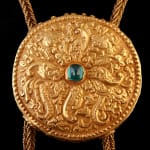Khmer Gold Necklace Inlaid with an Emerald and Two Rubies, 12th Century CE - 14th Century CE
Gold, Emerald, Ruby
68.6 x 8.3 cm
27 x 3 1/4 in
27 x 3 1/4 in
CK.0034
Further images
The Khmer civilization, today embodied by the temples and ruins of Angkor, one of mankind's most astonishing and enduring architectural achievements, flourished from 802-1431 A.D. From the great citadel of...
The Khmer civilization, today embodied by the temples and ruins of Angkor, one of mankind's most astonishing and enduring architectural achievements, flourished from 802-1431 A.D. From the great citadel of Angkor, the kings of the Khmer empire ruled over a vast domain that reached from what is now southern Vietnam to Yunan, China and from Vietnam westward to the Bay of Bengal. The original city was built around the Phnom Bakeng, a temple on a hill symbolizing the mountain that stands in the center of the world according to Hindu cosmology. Successive kings enlarged the city, building other temples devoted to various Hindu deities and large reservoirs used for irrigation, which also symbolized the ocean surrounding the holy central mountain.
The history of gold working in Ancient Cambodia is still relatively unknown, due in large part to the scarcity of remaining examples. Unlike other ancient cultures that interred their elite in resplendent burials along with signs of their wealth, such as jewelry, the Khmer created their deceased, depriving modern archaeologists of any possible tomb discoveries. However, there are numerous records that testify to the practice of goldworking during the Khmer era, both in their own inscriptions and in writings of neighboring cultures, including the Chinese. This magnificent necklace is composed of a long, complex loop-in-loop strand featuring two terminals decorated with the heads of the bird-like mythological creature Garuda. A central circular pendant decorated with floral motifs hammered into the gold has been strung along the necklace. Precious stone adorn the work, including an emerald in the center of the pendant and small rubies decorating each terminal.
The history of gold working in Ancient Cambodia is still relatively unknown, due in large part to the scarcity of remaining examples. Unlike other ancient cultures that interred their elite in resplendent burials along with signs of their wealth, such as jewelry, the Khmer created their deceased, depriving modern archaeologists of any possible tomb discoveries. However, there are numerous records that testify to the practice of goldworking during the Khmer era, both in their own inscriptions and in writings of neighboring cultures, including the Chinese. This magnificent necklace is composed of a long, complex loop-in-loop strand featuring two terminals decorated with the heads of the bird-like mythological creature Garuda. A central circular pendant decorated with floral motifs hammered into the gold has been strung along the necklace. Precious stone adorn the work, including an emerald in the center of the pendant and small rubies decorating each terminal.







